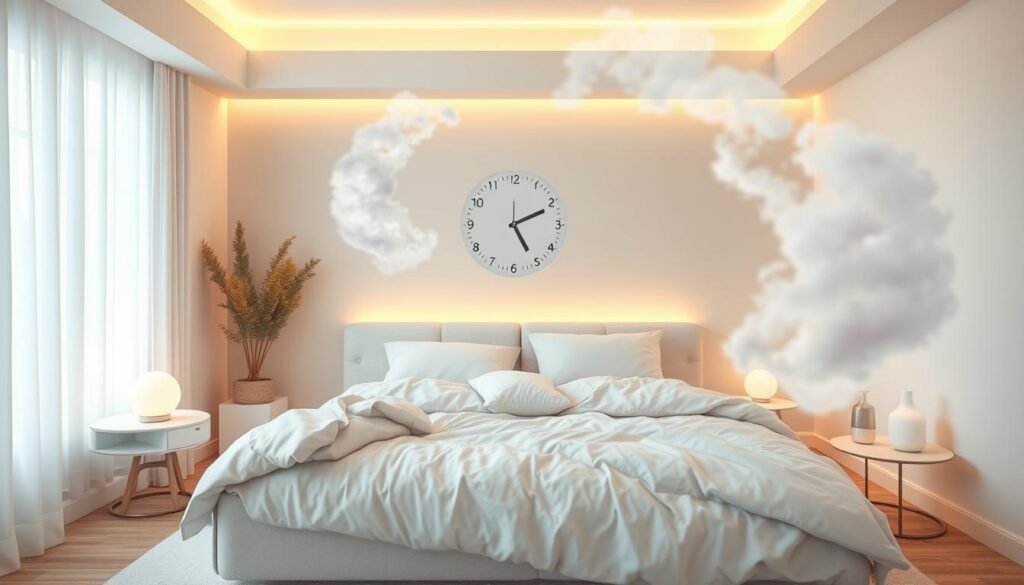Did you know that nearly 70 million Americans struggle with sleep disorders? This shows how much we need to find good solutions. Behavioral interventions have shown promise. By changing our habits, we can sleep better and feel better overall.
Therapies like sleep compression have really helped people. They help you fall asleep faster, wake up less during the night, and feel more satisfied with your sleep. Learning about behavior therapy gives us hope. It helps those with sleep problems get the rest they need.
Key Takeaways
- Behavioral interventions can effectively target sleep disturbances.
- Sleep compression therapy improves multiple sleep variables.
- High sleep efficiency indicates good sleep quality.
- Establishing a sleep diary is a crucial step in behavioral therapy.
- Individual assessments are recommended for the best treatment approach.
Understanding Sleep Disturbances
Millions of people are affected by sleep disturbances, making everyday life harder. These issues come from different sleep disorders, each with its own challenges. Knowing these causes is the first step in finding solutions for better sleep.
Common Types of Sleep Disorders
Insomnia is the most common sleep disorder, affecting about one-third of adults. Sleep apnea and restless legs syndrome are also major problems. These disorders have symptoms that can appear for various reasons, including stress or lifestyle factors.
Causes of Sleep Disturbances
Sleep problems have many causes, including emotional and physical health. Anxiety and stress, for example, can ruin a good night’s sleep. Bad habits before bed and irregular sleep schedules make things worse.
Over 50 million Americans deal with chronic sleep disorders. This is a big issue for public health. Things like a noisy room or ongoing health problems also disrupt sleep.
Why Behavioral Interventions Matter
Behavioral interventions are vital for improving sleep quality. They help a large number of kids and teens suffering from sleep issues like insomnia. Lack of good sleep affects them in many ways. It can hurt their thinking and how well they do in school.
Impact on Sleep Quality
Behavioral interventions can greatly better sleep quality. About 30% of children and 24% of teens have trouble sleeping, more so if they have conditions like ADHD or anxiety. Using specific strategies, such as teaching about sleep and improving sleep habits, can really help. These methods focus on the individual’s needs, greatly improving sleep quality for those with insomnia.
Long-Term Benefits of Behavioral Changes
Behavioral changes offer long-term benefits that go beyond just better sleep. When kids learn these methods, their life quality improves. They become happier, think clearer, and show fewer behavioral issues. These changes also help in preventing obesity and risky behaviors. Teaching kids about these habits can lead to a healthier life as they grow older.
| Behavioral Intervention | Target Group | Duration | Key Components | Expected Outcomes |
|---|---|---|---|---|
| Cognitive Behavioral Therapy for Insomnia (CBT-I) | Children and Adolescents | 6 sessions or less | Sleep education, hygiene strategies | Improved sleep quality |
| Sleep Education Programs | Pediatric Populations | Variable | Information dissemination, discussion | Increased awareness |
| Group Interventions | Adolescents with Insomnia | Short-term | Peer support, shared strategies | Enhanced coping skills |
Behavioral Interventions for Sleep
Many techniques can help improve your sleep. They tackle insomnia and aim to make sleep better. Using behavior therapy for sleep issues is key. It helps create a good sleep plan. Knowing about these methods is great for those struggling with sleep problems.
Overview of Available Interventions
The top techniques include:
- Cognitive Behavioral Therapy for Insomnia (CBT-I): This strategy challenges negative thoughts about sleep. It works to make sleep better with focused sessions. It uses cognitive therapy to change wrong beliefs about sleep.
- Sleep Hygiene Practices: These habits are vital. They involve keeping a regular sleep time, cutting down caffeine, and making your bedroom peaceful (cool, dark, and quiet).
- Sleep Restriction Therapy: It boosts sleep efficiency by limiting bed time. This is based on your sleep patterns.
- Stimulus Control: This teaches you to associate your bed with sleep only. It aims to make the bed a cue for sleeping, not being awake.
Target Audience for Behavioral Interventions
Several groups will find these sleep interventions helpful:
- People fighting insomnia, which impacts a third of adults.
- Those who are dealing with ongoing stress from big life changes or events.
- Patients in care settings, like hospitals, where sleep issues are often seen.
Knowing who benefits from these approaches is key. This ensures the right sleep habits are promoted. Also, being informed about these options is crucial. For extra details on how behavior affects sleep, check this source.
| Intervention Type | Description | Target Audience |
|---|---|---|
| CBT-I | Changes negative thoughts about sleep. | Those suffering from frequent insomnia. |
| Sleep Hygiene | Lifestyle adjustments for improving sleep. | Everyone, especially if you struggle with sleeping. |
| Sleep Restriction Therapy | Better sleep efficiency through planned scheduling. | People with inconsistent sleeping times. |
| Stimulus Control | Makes the bed a symbol of sleep and rest. | Individuals with bad sleep habits. |
Exploring Sleep Compression Therapy
Sleep compression therapy is a new way to improve sleep quality by cutting bed time. It boosts sleep efficiency, especially for those with insomnia. By making sleep time shorter but more effective, people can get better sleep and feel well overall.
What Is Sleep Compression Therapy?
This method makes individuals gradually spend less time in bed but sleep better. It helps people overcome the mental barriers of insomnia. Studies show that it makes sleep more efficient and transforms bad sleep into good sleep.
Comparing Sleep Compression and Sleep Restriction Therapy
Sleep compression and sleep restriction therapy both aim to tackle insomnia differently. Sleep restriction cuts down bed time to up sleep’s share. It’s tweaked as the person gets better. While sleep compression offers quick fixes, sleep restriction therapy might help more in the long run, especially for chronic insomnia sufferers.

Distinguishing between these therapies helps customize treatment. Since sleep issues affect emotional and mental health, using cognitive therapy techniques might help too. For more info on this, check out CBT-I techniques.
Cognitive Behavioral Therapy for Insomnia (CBT-I)
Cognitive Behavioral Therapy for Insomnia (CBT-I) is a top method for treating chronic insomnia. This affects about 6–10% of people. It focuses on changing the thoughts and behaviors that mess up sleep. Techniques like cognitive restructuring and sleep hygiene education help make sleep better.
Understanding CBT-I Techniques
CBT-I usually takes six to eight sessions to complete, with each session lasting from 30 to 90 minutes. The main parts of this therapy include:
- Cognitive Therapy (CT): Helps change negative thoughts about sleep.
- Stimulus Control Therapy (SCT): It involves doing sleep-related activities only if feeling sleepy and leaving bed if sleep doesn’t come within 15–20 minutes.
- Sleep Restriction Therapy (SRT): Aims to make sleep more focused and uninterrupted.
- Sleep Hygiene (SH): Encourages changes in lifestyle and environment to improve sleep conditions.
These CBT-I methods are effective in fighting insomnia. They enhance sleep quality, lessen the time it takes to fall asleep, and reduce waking up during the night.
Effectiveness in Treating Insomnia
Studies show CBT-I’s success in treating insomnia. A 2024 study with over 31,000 people showed its strength as a primary choice. It helps not just adults but also kids and teens with sleep problems. For those with chronic illnesses impacting sleep, CBT-I improves sleep routines.
CBT-I might also add methods like relaxation and paradoxical intent. While some may choose sleeping pills for quick relief, CBT-I is a top non-drug option. With more apps and online programs, there’s even easier access to resources for better sleep.
| CBT-I Techniques | Description | Benefits |
|---|---|---|
| Cognitive Therapy | Identifies and alters negative thought patterns surrounding sleep. | Enhances realistic thinking, reducing anxiety about sleep. |
| Stimulus Control | Encourages sleep-related activities only when sleepy. | Improves sleep efficiency and reduces wakefulness. |
| Sleep Restriction | Limits time in bed initially to improve consolidated sleep. | Increases sleep drive and reduces insomnia symptoms. |
| Sleep Hygiene | Modifications for better sleeping conditions and routines. | Creates an optimal sleep environment fostering quality rest. |
Relaxation Techniques for Better Sleep
Effective relaxation tricks can make sleep better. Many adults can’t sleep well because of stress and anxiety. Using relaxation methods helps people feel calm. This calmness helps you fall asleep faster and stay asleep all night.
Benefits of Deep Breathing Exercises
Deep breathing has many benefits. It helps release tension and brings a sense of peace. Diaphragmatic breathing works the diaphragm muscle. This reduces stress and makes you feel relaxed. The 4-7-8 technique controls how fast you breathe. It helps you relax and sleep better.
Incorporating Mindfulness and Meditation
Mindfulness and meditation help with sleep, too. Using your imagination with exercises like body scans and yoga nidra calms your mind. These methods make falling asleep easier. Progressive muscle relaxation also helps. It involves tensing and loosening muscle groups to relax fully.

Practicing deep breathing and mindfulness for 20 to 25 minutes daily improves sleep. Combining these with good sleep routines makes it even better. Sticking to a regular sleep schedule is key. These techniques can lead to better sleep and better health overall.
Improving Sleep Quality Through Behavior Changes
Improving sleep quality can start with simple behavior changes. Having a set sleep routine is key. It helps the body follow its natural sleep-wake cycle, improving sleep and well-being. Also, it’s important to remove things that make sleeping hard.
Establishing a Consistent Sleep Routine
Having a regular sleep schedule is crucial. Going to bed and waking up at the same times everyday helps set your body’s clock. This makes falling asleep easier and deepens sleep. For better sleep, avoid caffeine before bed, create a calm sleeping area, enjoy relaxing pre-bed activities, and have a wind-down period.
- Avoiding caffeine 6-8 hours before bedtime
- Creating a calming bedtime environment
- Engaging in relaxing activities such as reading
- Establishing a pre-sleep wind-down period
These steps can greatly improve sleep quality.
Identifying and Eliminating Disruptive Factors
Removing sleep blockers is important for good sleep. Things like too much screen light, a bad sleep setting, and certain foods can interrupt sleep. Try these tips:
- Minimize blue light exposure one hour before sleep
- Maintain a cool, dark, and quiet bedroom
- Avoid stimulants like nicotine and alcohol late in the day
- Limit naps, or schedule them early to prevent interference
Understanding and eliminating these issues can lead to better sleep and improved life quality.
| Disruptive Factors | Effects on Sleep | Recommended Actions |
|---|---|---|
| Caffeine | Disturbs sleep, especially in sensitive individuals | Avoid 6-8 hours before bedtime |
| Nicotine | Acts as a stimulant, affecting sleep onset | Avoid before bedtime |
| Alcohol | Initial aid for sleep onset but disrupts later stages | Avoid after dinner |
| Bedroom Environment | Affects overall comfort and sleep quality | Keep cool, dark, and quiet |
Using these strategies can help you sleep better, improving your mental and physical health.
Sleep Hygiene Practices
Sleep hygiene is key to better sleep quality. It includes various practices that help you fall and stay asleep. Good sleep hygiene improves sleep and helps with sleep disorders.
What Is Sleep Hygiene?
Sleep hygiene is about habits that promote good sleep. These habits include a regular sleep schedule, a comfy sleep environment, and relaxation before bed. These are vital for better sleep and fighting insomnia.
Tips for Maintaining Good Sleep Hygiene
Here are simple tips for maintaining good sleep hygiene:
- Have a regular sleep routine, going to bed and waking up at the same times every day.
- Create a calming bedtime routine like reading, meditating, or stretching.
- Make your sleeping area ideal; keep it dark, quiet, and cool. Choose a comfy mattress and pillows.
- Stay away from caffeine and nicotine before bed. They can disrupt your sleep.
- Cut down on using phones or computers an hour before bed.
- Be active during the day. It helps with night-time sleep.
- Use cognitive behavioral strategies to deal with negative thoughts that affect sleep.
Keeping up with these habits is crucial for good sleep. It’s also key for behavioral sleep solutions. For more on sleep issues, check out managing sleep maintenance insomnia.
Good sleep hygiene can really improve your sleep. By diligently following these tips, you can beat insomnia and create a restful sleeping environment.
Behavior Therapy for Sleep Disorders
Behavior therapy for sleep disorders uses a planned method to manage problems like insomnia. About 10% of people suffer from insomnia. So, knowing about different behavior therapies helps choose the best one.
Types of Behavioral Therapies Available
There are many kinds of behavioral therapies. They are designed to suit each person’s needs and likes. Some well-known options include:
- Individual Therapy: This allows therapists to make custom plans for patients, ideal for tackling unique issues.
- Group Therapy: People with similar problems can share and find solutions together in this setting.
- Family Therapy: Involving family helps improve support and deal with common stress that affects sleep.
One therapy style is Cognitive Behavioral Therapy for Insomnia (CBT-I). It focuses on changing bad thought patterns that ruin good sleep.
How Therapy Can Target Individual Needs
Different therapy methods target specific needs for the best results. For example, the Brief Behavioral Treatment for Insomnia (BBTI) takes four weeks. It includes strategies like sleep restriction and stimulus control. Sessions in person or via phone make it easy for everyone to join in.
Studies prove it works well, with people enjoying better sleep. Techniques like limiting bed time to only sleeping show how flexible therapy can be. These strategies do more than ease symptoms. They lead to lasting improvements in sleep habits.
| Type of Therapy | Duration | Focus | Typical Setting |
|---|---|---|---|
| Individual Therapy | 30-90 minutes per session | Custom strategies | In-person or online |
| Group Therapy | Varied based on topics | Support and shared experiences | In-person or online |
| Family Therapy | Depends on family dynamics | Family involvement | In-person |
Sleep Behavior Modification Strategies
Effective strategies can greatly improve sleep quality. It’s key to know about sleep latency, or how long it takes to fall asleep. By focusing on this, one can make their sleeping area better and build habits for good rest.
Understanding Sleep Latency and Its Management
To manage sleep latency, specific methods are used to shorten the falling asleep time. Cognitive-behavioral therapy for insomnia (CBT-I) is a standout option. Harvard Medical School research shows CBT is better than meds for chronic insomnia. Users often sleep faster and stay asleep longer. With regular use of these strategies, the improvements can last even after stopping treatment.
Adjusting Daytime Activities for Better Nighttime Sleep
Changing day activities is key for better night sleep. Important tips include:
- Avoiding too much napping during the day. This helps keep the night sleep cycle regular.
- Doing regular exercise improves sleep patterns and quality.
- Cutting down on stimulating activities before bed. This includes reducing screen time to stay calm before sleep.
These tips match with strategies for better sleep. Adding relaxation exercises and mindfulness to daily life helps with sleep latency. A full plan that combines these strategies and smart day choices leads to better rest.

Conclusion
It’s vital to use behavioral changes to help solve sleep troubles. These affect lots of people, especially kids. In Brazil, 20-30% of children deal with sleep issues. Also, about half find it tough to fall asleep. This shows how important it is to find effective ways to help.
Behavioral approaches improve how quickly children fall asleep and night wakings. They also make bedtime less of a battle. These improvements are not just for now. They help kids in the daytime too. Kids perform better during the day. This boosts their overall happiness and health.
These interventions include regular sessions that help make lasting changes in behavior. They keep helping for up to two years after treatment. By following detailed sleep plans, people can handle sleep problems better.
Being open to trying these behavioral therapies helps kids and adults. Many adults struggle with insomnia but don’t often get help. Using smart tactics can lead to better sleep. This makes high-quality sleep possible for many, improving life overall.